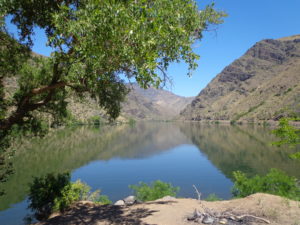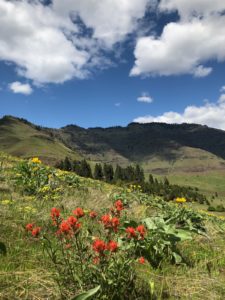Protecting Hells Canyon
“Standing in the quiet, watching the sunlight warm the landscape, I was overwhelmed with gratitude that we were able to protect this pristine place forever.”
-David Kirk, Senior Lands Specialist
Wander through any of the 360 miles of trails within Hells Canyon Wilderness and you’ll experience rocky slopes and grasslands dotted with Douglas Fir, Ponderosa Pine, western larch, prickly pear cactus and sagebrush. If you’re patient, you may witness Rocky Mountain elk or bighorn sheep expertly navigating the steep canyons.

View of the Snake River from the trailhead to McGraw Creek
However, the threat of development and destructive grazing still haunts many areas of the Hells Canyon Wilderness, which is why we are thrilled to report that on February 20 we transferred the McGraw Creek property on the Oregon side of Hells Canyon Wilderness to the U.S. Forest Service for permanent protection. McGraw Creek is a 138-acre parcel that sits on a scenic plateau just below the rim of Hells Canyon. The land boasts a stunning view of the Snake River and can be accessed via a U.S. Forest Service trail from the river. “I have hiked many wilderness properties, but the journey into the McGraw Creek property is one of my favorites,” says David Kirk, senior lands specialist with the Trust. “The trail works its way along the cliffs framing the Snake River and then shoots straight up to a large bench with commanding views of the rugged canyon. I was up there in early October, and the property was a patchwork of brilliant orange and red oak brush with a grove of old growth Douglas fir trees guarding the mouth of a side canyon. Standing in the quiet, watching the sunlight warm the landscape, I was overwhelmed with gratitude that we were able to protect this pristine place forever.”

Photo credit: Mike Montgomery, U.S. Forest Service
With the threat of development eliminated, the old-growth trees that stand majestically on the land will remain, as will the purity of the seasonal stream that flows through the property’s meadows – providing shelter and nourishment for the elk, mountain goats and black bear that hikers have spotted on the property.
How Hells Canyon Got Its Name
Hells Canyon is a 10-mile-wide canyon located along the border of eastern Oregon, eastern Washington and western Idaho. At 7,993 feet, it is North America’s deepest river gorge. Most people assume its depth was the inspiration behind the name, but it was actually christened Hells Canyon because of the wild and dangerous boat journey copper and gold miners took down the Snake River in the 1880’s to seek their fortune. The United States Congress designated the Hells Canyon Wilderness in 1975 and it now has a total of 217,613 acres, with approximately 86,276 acres in Idaho and approximately 131,337 acres in Oregon. It is managed by the Bureau of Land Management and the U.S. Forest Service.


